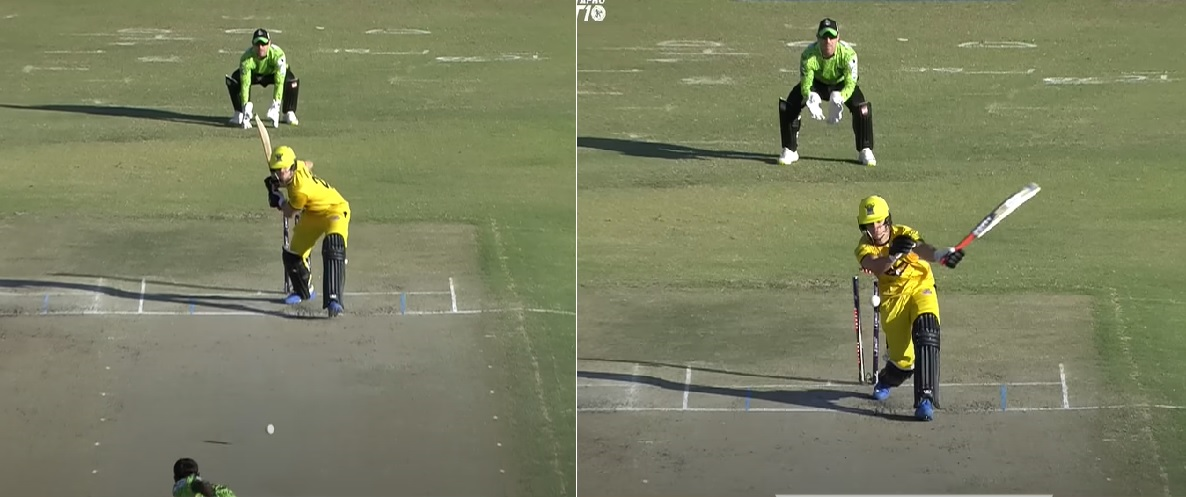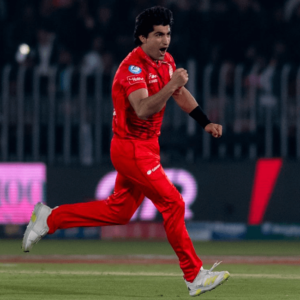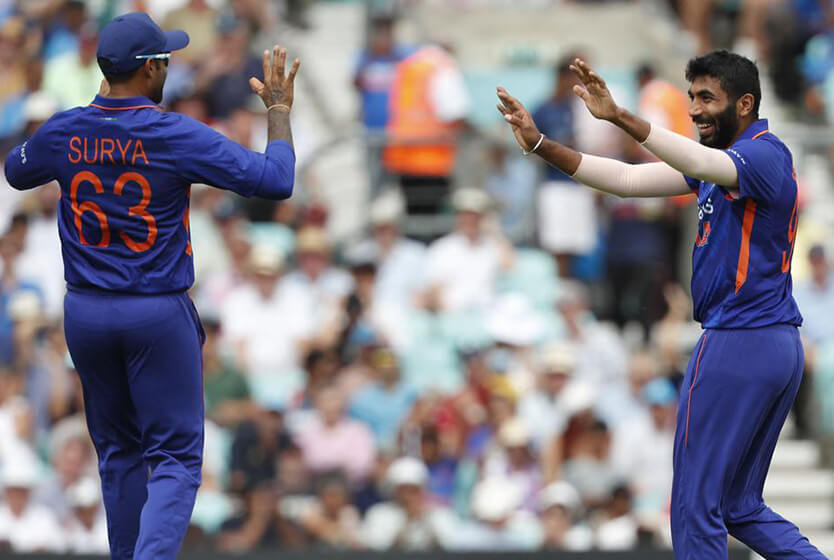
Lahore Qalandars and side-on sling bowlers, the love story
Getting Misbah-ul-Haq caught behind off his first ball on his big leagues debut, Salman Irshad rekindled memories of Lasith Malinga for many with his slingy action, which had been an uncommon sight among Pakistan’s bowlers since Shoaib Akhtar’s retirement in 2011. Irshad is a product of Lahore Qalandars’ Players Development Program (PDP) from its 2017-18 cohort. Lahore has always been spoiled for choice when it comes to fast bowling options. Since its initiation in 2016, the PDP has had an unapologetic bias towards producing pacers, and among its most notable graduates who have gone to play in the PSL are Salman Irshad, Dilbar Hussain, Ahmed Daniyal, and its most acclaimed product, Haris Rauf.
Lahore’s unmissable love for tape-ball speed sensations is only rivaled by its obsession with bowlers with unorthodox bowling actions. Be it Ali Majid’s quick-arm leg-spin rockets, Yasir Jan’s ambidexterity, or Mohammad Irfan Jnr.’s windmill routine, Lahore has always been on the lookout for something different. At the intersection of its two preoccupations lie sling-arm fast bowlers. Since 2018, they have drafted three ‘slingers’ in the squad: Irshad (2018, 2020), Zaman (2022, 2023), and Jalat Khan (2023). While Jalat, unsurprisingly, could not displace Zaman in the line-up and get a game, between them, Zaman and Irshad have featured in 34 of Lahore’s last 69 matches since 2018 and achieved noticeable success. In 2020, Irshad’s last season for Lahore, he took 7 wickets in 5 matches at a bowling average of 20.4, and while his economy was 11, his dot ball percentage was 44.9%. Meanwhile, Zaman’s success in the past two seasons is known to all and has already catapulted him into national team conversations while earning him an ODI and 6 T20I caps to date.
Being unique, being better?
Sling-arm pacers are a wildcard in the pack. In the latest edition of the Lanka Premier League, two of the three highest wicket-takers among pacers – Matheesha Pathirana and Nuwan Thushara – bowled with extreme side-on sling actions. Slingers are most effective in short-format cricket for a few reasons: first, batters don’t face sling-arm bowlers regularly enough at any level; for a skill to penetrate the subconscious, it requires repetition of an action. In Pakistan’s domestic circuit today and globally, sling-arm fast bowlers are a rare sighting, and their participation in long-format cricket is rarer. As a result, batsmen are ‘not as tuned’ to such bowlers, and a ball delivered from an unnaturally wide bowling angle bypasses the batsman’s subconscious ability to detect early cues and triggers from the action, forcing them to revert to conscious movements which can affect their reaction time significantly. Unsurprisingly, this challenge is exacerbated as the format gets shorter, with batsmen needing to ‘pre-empt’ more and make an earlier decision on attacking shots, which further reduces the reaction time and, therefore, increases the sling-arm bowler’s advantage.
Side-on sling bowlers are uncommon in longer-form cricket for two reasons: first, as the game gets more spread out, the bowlers’ advantage diminishes as batsmen are now operating without any time pressure, and the more deliveries they are able to play out, the more they get ‘dialed in’ on the release points. As evidenced by the numbers returned by four active slingers in modern-day cricket below, sling-arm bowlers thrive in T20s, and the competitive advantage diminishes as the game gets longer.
All four bowlers have played more than double the amount of T20s than they have List A matches. In Zaman’s case, he has played 60 more T20s than he has List A matches. Barring Thushara, the other three pacers have a poor List A record in the limited matches they have played, averaging noticeably worse than their T20 bowling average, and, in Irshad and Zaman’s cases, their averages drop by twice as much. Furthermore, between the four of them, they have played a total of 9 First Class matches (compared to 226 total T20s) at a weighted bowling average of 81.33, with Zaman having played none.
Another reason why side-sling fast bowlers are uncommon in long-form cricket is because it is the most likely bowling action to get wrong. It provides extremely little margin for error when trying to hit the intended line and length and thus requires a lot more practice to get consistency compared to a more traditional, high-arm action. These bowlers are most commonly associated with speed, rarely with accuracy, with its biggest exponents, Shoaib Akhtar and Shaun Tait, having actions that were optimized for nothing but speed. Barring Lasith Malinga, who was a cricket unicorn, extreme side-on sling bowlers have historically been largely inconsistent, stupid quick, and injury-prone. It’s a double-edged sword – what makes side-on sling bowlers exciting is also what makes them unsustainable and more favorable to twenty-overs cricket.
Lahore’s latest ‘slinger’ from Jhang
Leading up to this year’s Pakistan Super League draft, there is little reason to doubt that the two-time defending champions will deviate from their now-proven strategy of loading up on academy players, particularly pacers. In keeping with tradition, the Qalandars pace factory has produced a new fast bowling prospect, this time a ‘slinger.’ Lahore’s latest academy recruit is a 28-year-old welder-turned-cricketer from Kot Lakhana, Jhang. Tayyab Abbas, known as ‘Mithoo Malinga’ in the tape-ball world, was selected as part of the Players Development Program Class of 2022 when he impressed Aqib Javed and Yorkshire’s Darren Gough with his slingshot bowling action and the pace it generated. Darren Gough, in particular, was dazed to see Tayyab bowl at 87 mph (140 kph) while wearing trainers with no spikes, having little to no landing stability, nor a textbook bowling grip. Since then, Tayyab has been training at the Qalandars High Performance Centre.
Tayyab’s maiden televised appearance came when Lahore Qalandars’ development side went up against PCB XI in a T-10 Exhibition Match at Narowal Sports City Complex in May. Tayyab came on to bowl in the fourth over and sent Abid Ali’s off-stump cartwheeling with his second ball. In his two-over spell, Tayyab would go on to bowl at Asif Ali and Khushdil Shah, two of Pakistan’s most prominent power hitters, and end with figures of 17-1, the most economical spell across both teams on a pitch where runs were scored at 12 runs per over. On two separate occasions – the ball that dismissed Abid Ali and a dot ball to Asif Ali – the batters completely misread the ball and struggled to connect despite maintaining a low stance due to the unusual bounce variation induced by Tayyab’s action.
Tayyab received a huge vote of confidence from the Qalandars’ management when he was drafted by the Durban Qalandars in the inaugural edition of the Zim Afro T-10. Competing with Mohammad Amir and Azmatullah Omarzai for the overseas pacers spots, Tayyab started on the bench but made his debut halfway into the tournament. In his third game, Tayyab played back his dismissal of Abid Ali from the exhibition game in Narowal by producing an identical ball, a low-bouncing off-cutter, to dismiss a Will Smeed dropped to one knee. Arguably, in that lies Tayyab’s best-known variation – his off-cutter that barely bounces due to his low release point, which makes it harder for batters to judge the bounce and allows greater deception off the pitch.
Tayyab would go on to collect a winner’s medal in his debut tournament and finish the tournament as one of only three pacers – Sheldon Cottrell (7.21) and Taskin Ahmed (7.85) – with an economy rate of less than 10 runs per over (9.87). Among the tournament’s top ten most economical pacers, Tayyab was one of only two players uncapped at the international level – the other one being South Africa’s Nandre Burger (43 T20s) – with Tayyab the only one on the list who is yet to make his professional T20 debut.
While it is an obviously small sample size to draw conclusions about whether Tayyab has something special in him, his rapid development in only his first year of playing any professional cricket will excite Lahore, who have been testing the waters by including him as a net bowler in last year’s Pakistan Super League, taking him to Namibia, drafting him for the Durban Qalandars in the Zim Afro T-10, and also selecting him as part of Aqib Javed-coached Khairpur Royals in the inaugural draft of the (now postponed) Sindh Premier League.
Same same, but different
Ever since the advent of their Players Development Program, Lahore’s pace reserves have been an embarrassment of riches. Even looking past that, they already have a proven side-on sling bowler in Zaman Khan, who is younger, tested, a death overs machine, and someone likely to remain a critical pillar of the Qalandars’ pace attack for many years to come – which rightfully begs the question, why even bother investing in Tayyab. Similar to how no two left-arm or right-arm fast bowlers are the same, not all sling bowlers are the same either. Despite both having extreme side-on bowling actions, Zaman and Tayyab have some obvious mechanical differences that make them unique in their own capacities.
In the absence of kinematic or synchronized frame-by-frame data, it can be manually observed that Tayyab has a stronger pivot of his front hip and a higher delivery stride, mimicking a javelin thrower. Unlike Salman Irshad, whose action is semi-open, both Zaman (top right) and Tayyab (top left) have extreme side-on bowling actions. Compared to Zaman, though, Tayyab’s arm extends and stretches out more than Zaman’s does before release, which determines how much pace side-on bowlers are able to generate through their actions. As a result of this, Tayyab’s action creates a bigger separation between his bowling side hip and shoulder, and this stretch between the body parts is how he is able to bowl quicker.
Both Zaman and Tayyab also release the ball at different shoulder angles, which can create a variation of up to 30% in bowlers’ release speed. While not as low as Irshad (top right) or Pathirana, who deliver the ball from near-horizontal angles, Tayyab’s (top center) bowling arm gets much lower than Zaman’s (top left), with an assumed 20-25° variance based on preliminary footage investigation.
For Zaman, that provides him with a more pronounced dip when he bowls the slower ball. For Tayyab, it makes him effective in other ways – his bounce variation, as noted above, and he is more likely to reverse the older ball due to his lower release point, similar to Mohammad Wasim Jr. and Salman Irshad, who are exponentially more effective with their ‘tailing-in’ yorkers during the death overs than at any other stage of the innings. Since 2022, Salman Irshad (for Peshawar Zalmi) is averaging 15.1 between overs 16-20 with a 43.1% dot ball percentage, and averaging 31.4 across all other phases. In that same time period and the same 16-20 overs phase, Zaman is also averaging 10.1 with a 43.9% dot ball percentage for Lahore. While Lahore’s title-winning pace trio will likely continue as the status quo unless there is an injury scare, the novelty around a bowler like Tayyab will likely put him in contention, especially the tantalizing prospect of him and Zaman playing in the same line-up and troubling batsmen with the variation in release points.
Like the wild ones
Side-sling bowlers will never not be exciting, particularly as the game continues to get shorter. Multan Sultans, too, have been working closely with one – Swat-born Amin Ullah, who is rapid and was extremely impressive during the Tareen Academy’s (now Sultans Elite Squad) title-winning performance in the final of this year’s 8th Corporate T20 Cup, and would be on the Sultans’ radar in the emerging category. However, patience is a virtue with bowlers like Tayyab and Amin Ullah, who are coming through non-traditional cricketing pathways.
After Irshad, Zaman, and Jalat, Tayyab is now Lahore Qalandars’ latest submission into Pakistan cricket’s growing collection of high-potential slingshot bowlers. Tayyab’s ‘feel-good’ story – as a welder-turned-cricketer who took up tape-ball cricket only a few years ago at his uncle’s insistence, now standing at the doorstep of the country’s biggest cricketing stage – serves to humanize cricket and its athletes. Whether or not he is able to find or create space for himself in an already-crowded pace attack is secondary to the larger conversation, which speaks to Lahore Qalandars’ love for pacers, especially the wild ones.
The opinions expressed solely belong to the writer and do not necessarily reflect the views of Grassroots Cricket.












Leave a Reply